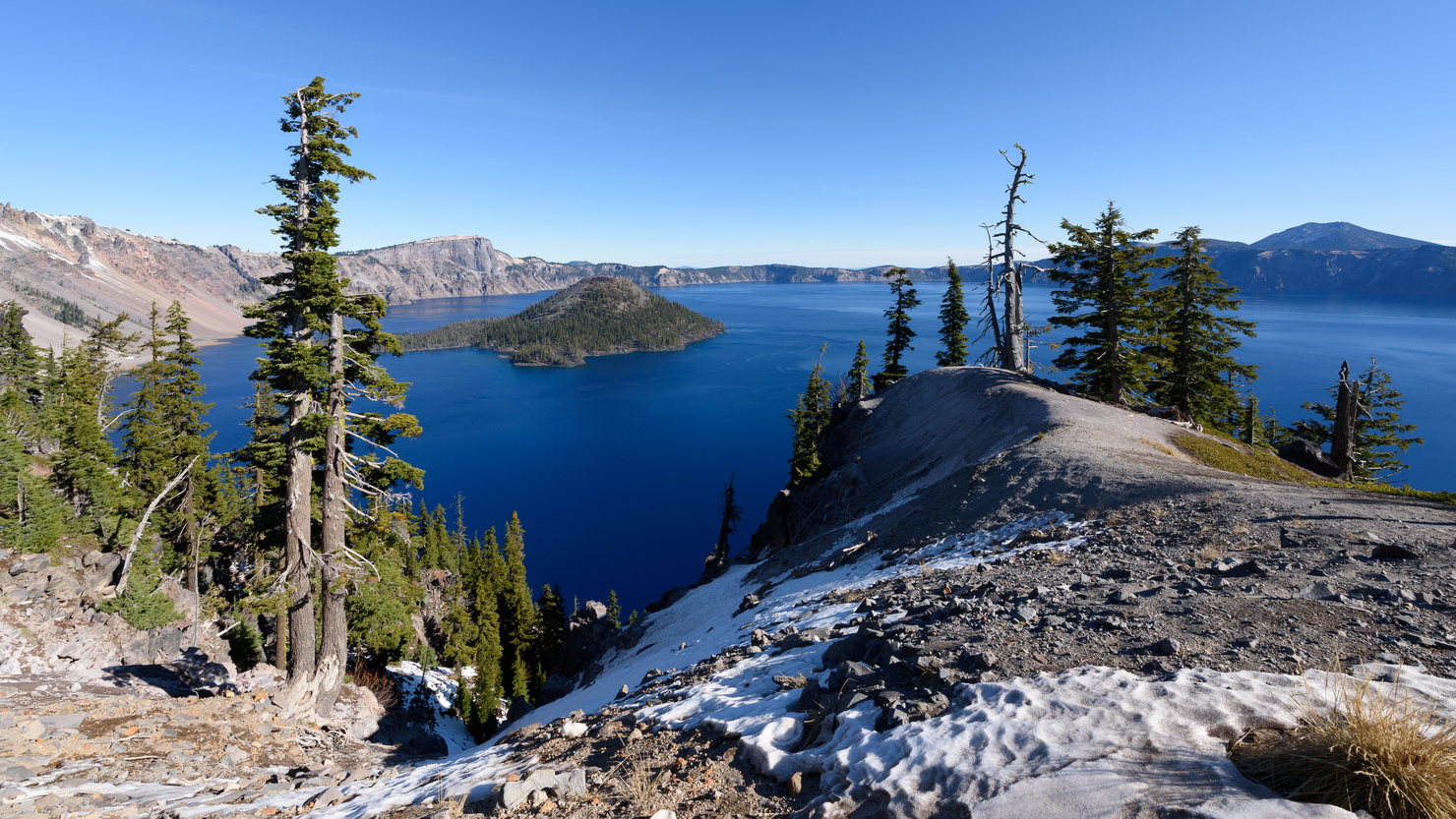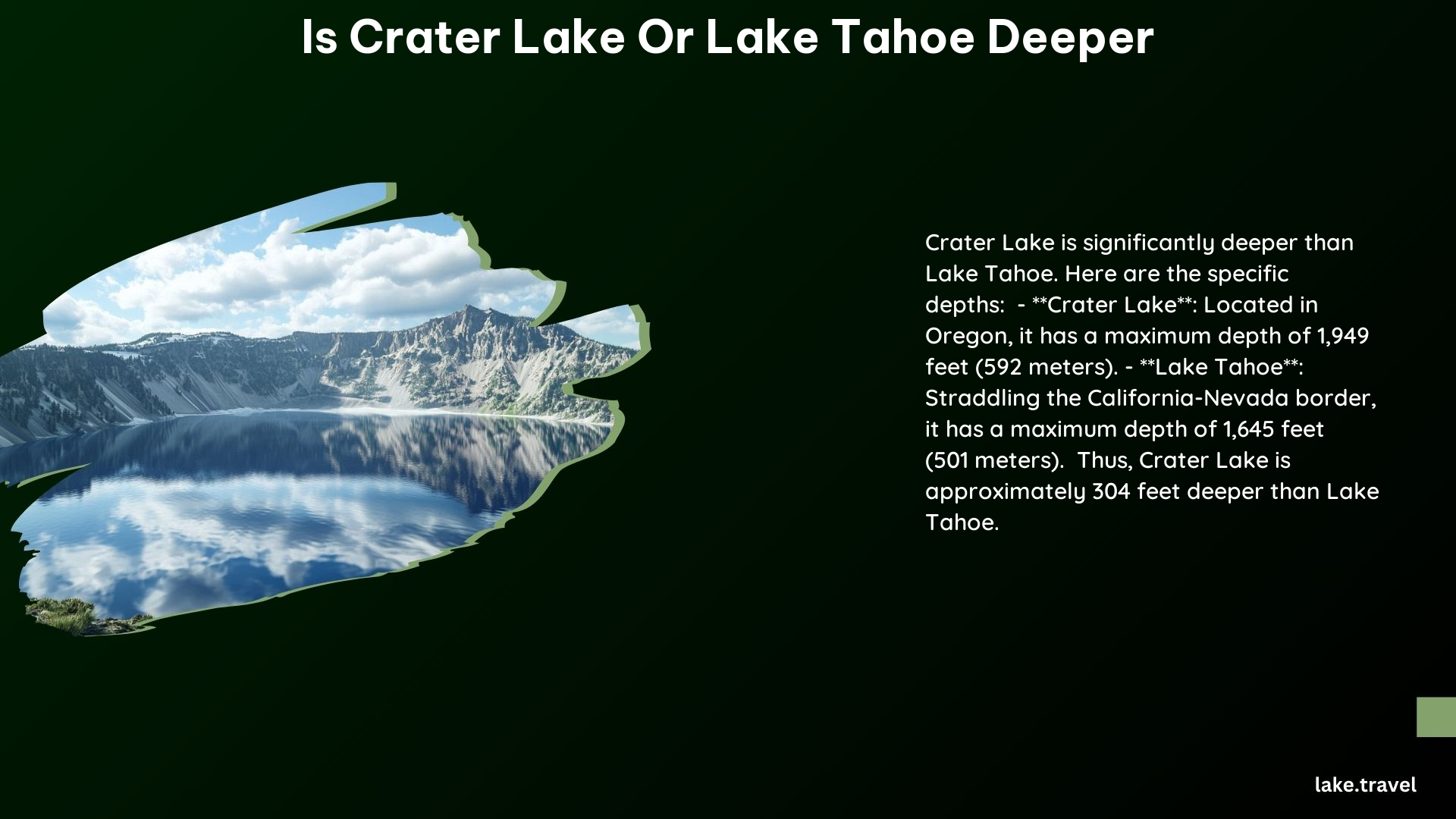Crater Lake and Lake Tahoe are two of North America’s most iconic and breathtaking lakes, each boasting impressive depths and crystal-clear waters. When comparing these natural wonders, the question of which is deeper often arises. Crater Lake, with its maximum depth of 1,943 feet, surpasses Lake Tahoe’s 1,645 feet, making it the deeper of the two. This article delves into the depths, characteristics, and unique features of both lakes, providing a comprehensive comparison for lake enthusiasts and travelers alike.
What Makes Crater Lake Deeper Than Lake Tahoe?

Crater Lake’s exceptional depth is a result of its volcanic origin. Formed approximately 7,700 years ago when Mount Mazama collapsed after a massive eruption, the caldera filled with rainwater and snowmelt over time. This geological history contributes to its impressive depth and near-perfect circular shape.
Lake Tahoe, while not as deep as Crater Lake, is still one of the deepest lakes in North America. Its formation is attributed to glacial activity and tectonic shifts in the Sierra Nevada mountain range. The lake’s depth is a testament to the powerful geological forces that shaped the region over millions of years.
Here’s a comparison of the two lakes’ depths:
| Lake | Maximum Depth | Average Depth |
|---|---|---|
| Crater Lake | 1,943 feet (592 meters) | 1,148 feet (350 meters) |
| Lake Tahoe | 1,645 feet (501 meters) | 1,000 feet (305 meters) |
How Does the Water Temperature Differ Between the Two Lakes?

The depth of these lakes significantly influences their water temperatures, creating distinct environments for aquatic life and recreational activities.
Crater Lake:
- Summer water temperature averages around 57°F (13.9°C)
- Cold temperatures persist due to the lake’s extreme depth and limited inflow
Lake Tahoe:
- Summer water temperature averages around 68°F (20°C)
- Warmer temperatures make it more suitable for swimming and water sports
The colder waters of Crater Lake contribute to its exceptional clarity, as the low temperatures inhibit algae growth and other biological processes that can cloud water.
What Are the Size Differences Between Crater Lake and Lake Tahoe?
While Crater Lake may be deeper, Lake Tahoe significantly surpasses it in terms of surface area:
- Crater Lake covers approximately 20.6 square miles
- Lake Tahoe spans about 191 square miles
This size difference impacts the range of activities and development around each lake. Lake Tahoe’s larger surface area allows for more extensive recreational opportunities and lakeside communities, while Crater Lake’s smaller size contributes to its more pristine and untouched appearance.
How Do the Origins of These Lakes Affect Their Characteristics?
The unique origins of Crater Lake and Lake Tahoe play a crucial role in shaping their individual characteristics:
Crater Lake:
- Volcanic origin from the collapse of Mount Mazama
- No inlets or outlets, fed solely by precipitation
- Extremely clear water due to lack of sediment inflow
Lake Tahoe:
- Formed by glacial activity and tectonic shifts
- Fed by 63 tributaries, with only one outlet (the Truckee River)
- Clear waters, but with more biological activity than Crater Lake
These distinct origins contribute to the lakes’ unique ecosystems, water clarity, and overall appearance.
What Unique Features Can Visitors Expect at Each Lake?
Both lakes offer visitors stunning natural beauty and unique attractions:
Crater Lake:
- Wizard Island: A cinder cone rising 763 feet above the lake’s surface
- The Old Man of the Lake: A 30-foot hemlock log that has been bobbing vertically in the lake for over a century
- Phantom Ship: A small island resembling a ghost ship, composed of erosion-resistant lava rock
Lake Tahoe:
- Emerald Bay: A picturesque inlet home to Fannette Island, the only island in Lake Tahoe
- D.L. Bliss State Park: Features the deepest measured point of the lake
- Underwater preserves: Including submerged forests and the wreck of the SS Tahoe
How Do Recreational Activities Differ Between the Two Lakes?
The distinct characteristics of each lake shape the recreational opportunities available to visitors:
Crater Lake:
- Boat tours to Wizard Island (seasonal)
- Hiking trails with panoramic views
- Scenic drives around the rim
- Limited swimming due to cold water temperatures
- Fishing (no license required, but only artificial lures allowed)
Lake Tahoe:
- Year-round activities including skiing, snowboarding, and snowshoeing in winter
- Extensive water sports: boating, jet-skiing, paddleboarding, and kayaking
- Numerous beaches for swimming and sunbathing
- World-class fishing opportunities
- Casinos and nightlife on the Nevada side of the lake
What Conservation Efforts Are in Place for These Natural Wonders?
Both Crater Lake and Lake Tahoe are subject to extensive conservation efforts to preserve their natural beauty and ecological importance:
Crater Lake:
- Protected as Crater Lake National Park since 1902
- Strict regulations on water activities to maintain water quality
- Ongoing research on the lake’s unique ecosystem and geological features
Lake Tahoe:
- The Lake Tahoe Environmental Improvement Program
- Efforts to combat invasive species and reduce algae growth
- Strict building regulations to preserve the lake’s shoreline and water clarity
These conservation efforts aim to ensure that future generations can continue to enjoy the pristine beauty of both lakes.
How Does Climate Change Impact These Lakes?
Climate change poses significant challenges to both Crater Lake and Lake Tahoe:
Crater Lake:
- Reduced snowpack affecting water levels
- Potential changes in water temperature impacting unique ecosystems
- Increased risk of wildfires in the surrounding forest
Lake Tahoe:
- Rising water temperatures affecting native species
- Reduced clarity due to increased algae growth
- Changes in precipitation patterns impacting water levels and quality
Ongoing research and conservation efforts are crucial in mitigating these impacts and preserving the lakes’ ecosystems.
What Are the Best Times to Visit Each Lake?
The ideal time to visit these lakes depends on your preferred activities and weather conditions:
Crater Lake:
- Summer (July to September): Best for boat tours, hiking, and clear views
- Winter (December to April): Opportunities for snowshoeing and cross-country skiing, but limited access due to snow
Lake Tahoe:
- Summer (June to August): Perfect for water activities and hiking
- Winter (December to March): Ideal for skiing and winter sports
- Fall (September to November): Less crowded with beautiful autumn colors
Consider the seasonal activities and weather patterns when planning your visit to make the most of your lake experience.
In conclusion, while Crater Lake holds the title of being deeper than Lake Tahoe, both lakes offer unique and awe-inspiring experiences for visitors. From their geological origins to their recreational opportunities, these natural wonders continue to captivate travelers and nature enthusiasts alike. Whether you’re drawn to the serene depths of Crater Lake or the vibrant shores of Lake Tahoe, both destinations promise unforgettable adventures and breathtaking scenery.
References:
1. Crater Lake Institute: How Deep is Crater Lake….Really?
2. National Park Service: The World’s Deepest Lakes
3. USDA – Lake Tahoe Basin Management Unit: Lake Tahoe Basin Mgt Unit – About the Area
